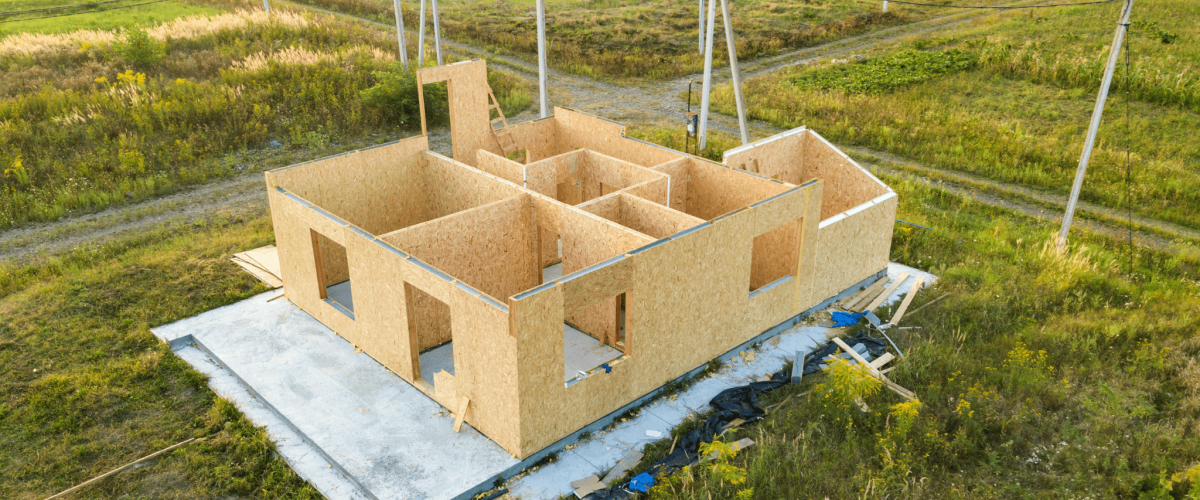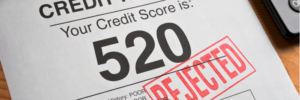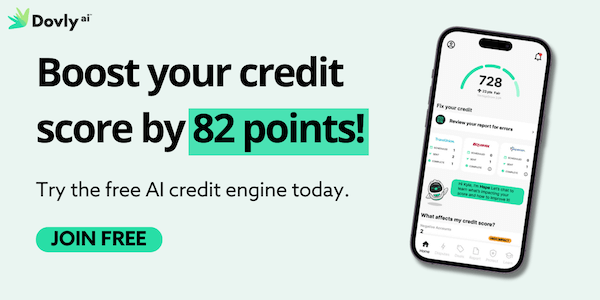How to Buy a Modular Home with Bad Credit

Buying a modular home with bad credit may seem challenging, but it’s more achievable than you think. Modular homes, also known as prefab homes, are often more affordable than traditional homes and offer various financing options that can work even if your credit isn’t perfect. This guide will walk you through the differences between modular, mobile, and manufactured homes, available loan options, and practical steps to improve your credit score. Plus, discover how Dovly AI can help you take control of your credit and move one step closer to homeownership.
Buying a home is one of the most exciting milestones in life, but when you’re doing it with bad credit, it can feel like an uphill battle. Fortunately, if you’re considering a modular home, often called a prefab home, you’re in luck. Prefab homes are often more affordable than traditional homes, making them an excellent choice for those navigating the challenges of bad credit.
Whether you’re looking for better financing options or just trying to figure out how to get approved, this guide will break down everything you need to know about buying a prefab home with bad credit. From financing options to improving your credit score, we’ve got you covered every step of the way. Plus, discover how Dovly can help you boost your credit to make homeownership a reality.
The Difference Between Modular, Mobile, and Manufactured Homes

When you’re comparing modular, mobile, and manufactured homes, it’s important to understand the classifications, especially in terms of financing and legal definitions.
Understanding the Terms
- Modular: These homes are built in sections in a factory and then assembled on-site. They meet local building codes, so they are treated similarly to traditional site-built homes, with the potential to appreciate in value.
- Manufactured Homes: Often mistakenly referred to as mobile homes, manufactured homes are built to meet strict federal HUD (Housing and Urban Development) codes. Unlike modular, manufactured homes tend to depreciate in value and may require specialized financing options. The term “mobile home” is sometimes still used, although it is outdated.
- Mobile Homes: Refers specifically to homes built before 1976 that don’t meet modern construction standards and are often considered personal property. These homes tend to depreciate in value and are typically harder to finance.
- Prefab Homes: A broad term that includes both modular and manufactured homes, as they are all built in factories before being assembled or transported.
Modular vs. Manufactured Home Loans
The lending process for modular and manufactured home loans can differ due to how they are classified by lenders.
Because they meet local building codes and are affixed to a permanent foundation, modulars are typically treated like traditional real estate. This makes financing easier, and buyers can often qualify for conventional mortgages, offering lower interest rates and longer terms.
Manufactured homes are considered personal property unless they are permanently affixed to a foundation. As such, financing is typically more complicated and may require a specific manufactured home loan, called a chattel loan, which tends to have higher interest rates and shorter terms than traditional mortgages. Keep reading for more details on lending options.
Understanding Lending
Mobile and manufactured homes often require personal property loans (chattel loans), while modular homes and site-built homes can qualify for traditional mortgages.
Mobile Home Loans
Mobile home loans are for homes built before 1976 and typically require chattel loans, which are personal property loans. Mobile home loans tend to have higher interest rates and shorter terms. Mobile homes generally depreciate over time.
Manufactured Home Loans
Manufactured home loans are for homes built after 1976 that meet HUD (Housing and Urban Development) codes. If the home is permanently affixed to land, it can qualify for a traditional mortgage. Otherwise, a manufactured home loan or chattel loan is required. Manufactured homes depreciate but at a slower rate than mobile homes.
Modular Home Loans
Modular home loans are for homes built in a factory that meet local building codes. These homes are typically eligible for traditional mortgages due to being affixed to land, which offer better interest rates and terms. These homes tend to appreciate over time, much like site-built homes.
Traditional Home Loans
Traditional home loans are for site-built homes and are typically the most favorable in terms of interest rates and terms. These homes also appreciate over time and are the standard for most home financing.
Lending Options for Prefab Homes
When considering financing for a prefab home, various lending options are available depending on your credit situation and location. Here’s an overview of the most common types:
Federal Housing Administration – FHA Loans
If you have a lower credit score (around 580), an FHA loan could be a viable option. These loans are backed by the Federal Housing Administration and tend to have more lenient credit requirements. They are a popular choice for buyers with bad credit, providing an opportunity to secure financing with a smaller down payment.
United States Department of Agriculture – USDA Loans
For those purchasing in rural areas, a USDA loan can be an excellent option. These loans often don’t require a down payment, which helps reduce upfront costs. They also have more relaxed credit requirements, making them an attractive option for those with less-than-perfect credit.
Conventional Loans
If your credit score is higher (typically 620 and above), you may qualify for this type of loan. These loans often offer better interest rates than government-backed loans, though they come with stricter requirements. These loans are ideal for those who meet the necessary financial criteria and are looking for competitive rates.
U.S. Department of Veterans Affairs – VA Loans
For veterans and active military personnel, VA loans offer the best benefits, including low interest rates and no down payment requirement. These loans are designed to support military members in purchasing a home with more favorable terms.
How to Choose the Right Lender
Whether you are applying for a mobile home loan, manufactured home loan, or a traditional home loan, choosing the right lender is crucial, especially when you have bad credit. Here are a few things to keep in mind throughout the home buying process:
- Interest Rates: Compare interest rates from different lenders to find the best deal. Even a small difference in rates can save you thousands of dollars over the life of the loan.
- Lender’s Reputation: Look for lenders who specialize in working with buyers with bad credit. Read reviews and check their track record to make sure they’re trustworthy. Various strategies can enhance the chances of loan approval, particularly for individuals with poor credit. Consider having a co-signer, offering collateral, making timely payments, and saving for a down payment.
- Loan Terms: Make sure you understand the loan terms, including the length of the loan, monthly payment schedule, and any fees.
Assessing Loan Terms and Conditions
When evaluating a home loan, it’s crucial to carefully review the terms and conditions. This includes the interest rate, loan term, monthly payment, and any fees associated with the loan such as closing costs. Borrowers should also consider the loan’s credit limit, which is the maximum amount that can be borrowed.
By thoroughly assessing these factors, you can ensure that you’re getting the best possible deal for your home loan. Understanding the full scope of your loan agreement will help you manage your finances more effectively and avoid any unexpected costs down the line.
Additional Resources
In addition to traditional loans, there are other resources that can help make buying modular prefab homes with bad credit more accessible:
Down Payment Assistance Programs
These programs offer financial help to first-time homebuyers, which can be a real game-changer if you’re struggling to come up with a down payment. Additionally, offering a higher down payment can enhance loan approval chances by lowering the lender’s perceived risk.
Grants for Homebuyers
Some states and municipalities offer grants or loans for homebuyers with bad credit, particularly if you’re purchasing in a designated area or meet certain income requirements.
How Credit Affects Financing
Your credit history plays a crucial role in determining your eligibility for financing and the terms of your loan when purchasing a modular or prefab home. Whether you are applying for a mobile home loan, manufactured home loan, or a traditional home loan, your score will influence the interest rates, down payment requirements, and loan options available to you. In some cases, lenders might also charge higher fees in closing costs to offset the perceived risk of lending to someone with a low credit score.
It’s also important to demonstrate a stable income to ensure your ability to manage monthly loan payments. Lenders often require documentation such as pay stubs and tax returns to verify your financial reliability.
Here’s a general breakdown of how your credit score affects financing:
750+ (Excellent): Qualify for the best rates, low down payments, and favorable terms. Access a wide range of lenders.
700-749 (Good): Still competitive options, though terms may be slightly less favorable than excellent scores.
650-699 (Fair): Higher rates and down payments. Financing is possible but may be less favorable.
600-649 (Poor): More difficult to qualify for financing. Subprime loans with higher rates and stricter terms may be your only option.
Below 600 (Very Poor): Challenging to qualify. Niche lenders may consider you with a co-signer or larger down payment.
Loan Specific Requirements
Different types of loans also have specific minimum credit score requirements. Here’s a breakdown of the most common loan options and their requirements:
FHA Loans: These loans typically require a minimum credit score of 580. However, higher scores may help you secure better terms.
Conventional Loans: Conventional loans generally require a minimum score of 620, but a higher score will make you a more attractive borrower and increase your chances of favorable terms.
VA and USDA Loans: These loans are more flexible with credit score requirements. While they may consider scores in the 620-640 range, a higher score will help improve your chances of approval.
As you can see, your credit score can significantly impact your financing. A higher score opens doors to better loan terms, lower interest rates, and more lender choices, making homeownership more affordable and achievable.
How to Improve Your Chances of Approval with Bad Credit
Even with bad credit, there are a few strategies you can use to improve your chances of getting approved:
Save for a Larger Down Payment – A larger down payment can make a big difference. The more money you put down upfront, the less risk you pose to the lender. If possible, aim for 20% to avoid private mortgage insurance (PMI) and show the lender you’re financially responsible.
Consider a Co-Signer – If you have a family member or friend with good credit, you might be able to get them to co-sign your loan. This reduces the lender’s risk and can make approval more likely.
Seek Subprime Lenders – Some lenders specialize in working with buyers who have bad credit. While the interest rates may be higher, they might be more willing to approve your loan.
Get Pre-Approved – A pre-approval letter gives you a clearer picture of your borrowing power and shows sellers that you’re a serious buyer. It can also help you avoid wasting time looking at homes you can’t afford.
How to Improve Your Credit
If you’re not quite there with your credit score yet, don’t worry—there are plenty of steps you can take to improve it. Here are some tips to help you raise your score over time:
Check for Errors
Errors on your credit report can drag your score down. Get a free report from the three major bureaus (Equifax, Experian, and TransUnion) and dispute any mistakes you find. Correcting these errors can help boost your score.
Pay Down Debt
Reducing your credit card balances and loans is key to improving your credit score. Aim to keep your credit utilization under 30%. Paying down high-interest debt first can help you save money and improve your credit faster.
Make Timely Payments
Payment history is one of the most important factors in your score. Set reminders or automate payments to ensure you never miss a due date.
Use Credit-Builder Tools
Services like Dovly can help you track your credit and create a personalized plan to improve your score. Dovly makes it easy to boost your credit, increasing your chances of getting approved for financing when you’re ready.
Avoid Opening Too Many New Accounts
Each new credit inquiry can lower your score slightly. Only apply for credit when necessary and avoid opening multiple new accounts at once.
Improving your credit score takes time, but by staying consistent with these steps, you can get closer to securing financing for your new prefab home. And with tools like Dovly, you’ll have the support you need to make the process smoother.

Conclusion
Buying a home, even modular, with bad credit may seem daunting, but it’s far from impossible. By understanding your lending options, improving your credit, and finding the right lender, you can increase your chances of approval and secure a home that fits your budget.
Remember, your credit score doesn’t have to hold you back forever—there are steps you can take to improve it, and services like Dovly are here to support you every step of the way. So don’t let bad credit stand in your way—take control of your financial future, and start your journey toward homeownership today!
Frequently Asked Questions



